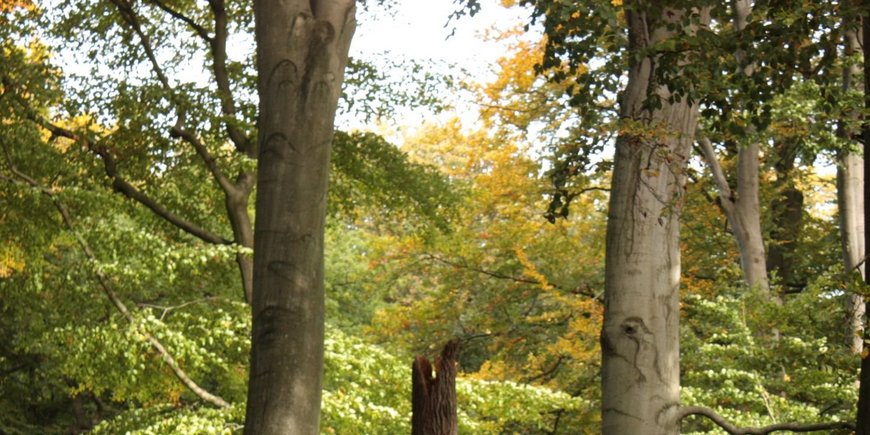2018 was a year of extreme weather in Germany. According to the Deutsche Wetterdienst DWD, the German Meteorological Office, it was the warmest and fourth driest year since the beginning of modern weather measurement series in 1881. But also in the Middle Ages, when weather data were not yet collected continuously, there were dry summers in Germany. Researchers around Tobias Scharnweber from the University of Greifswald have now succeeded in reconstructing the humiditx conditions in northern Germany for a timespan of thousand years. From GFZ, Ingo Heinrich from section Climate Dynamics and Landscape Evolution was involved in the study, which has now been published in the journal Scientific Reports.
Trees today develop much faster than in the past. This is partly due to the high availability of nitrogen from agriculture, industry and transport. The nitrogen reaches the forests via air and rain, where it leads to faster growth. Higher CO2 concentrations in the air also promote this growth. Provided sufficient water is available, these two factors lead to more growth in the forests.
As part of the current joint research project BaltRap ("The Baltic Sea and its Southern Lowlands: Proxy-Environment interactions in times of rapid changes"), in which GFZ is also involved, the researchers investigated annual rings of almost two thousand living beech trees and archaeological timber from the past thousand years. The annual rings are a unique archive of earlier environmental conditions. If the climatic conditions are good, they are wide, in unfavourable years – such as the dry year 2018 – growth is low and they remain narrow.
Using a specially developed data analysis method, the researchers were able to filter out non-climatic trends, such as the availability of nitrogen and CO2, from the growth rates of trees for the period from 1890 to 2014. They did this by calculating a mean value for these trends and then eliminate them from the measurement series of the individual samples. They thus obtained a more precise climate reconstruction for the north-eastern region of Germany.
"Our study is the first of its kind from northeast Germany, the core area of the climate observatory TERENO North-East established by GFZ in 2011," says Ingo Heinrich, co-author of the study and scientific coordinator of TERENO North-East. "The results allow us to place the high-resolution growth data of the recent years, which originate from our TERENO tree monitoring, in a data context of a thousand years. This way, we can better classify the growth behavior of the past years."
One important finding is that dry weather conditions in the summers of the Middle Ages – comparable to those in 2018 – were probably nothing unusual. The study also shows how important it is to statistically eliminate today's changed growth conditions in year-ring-based climate reconstructions. Thereby, the man-made share of current climate change can be placed in a long-term perspective of 'natural' fluctuations. (ph)
Original study: Scharnweber, T., Heußner, K.-U., Smiljanic, M., Heinrich, I., van der Maaten-Theunissen, M., van der Maaten, E., Struwe, T., Buras, A., Wilmking, M, 2019. Removing the no-analogue bias in modern accelerated tree growth leads to stronger medieval drought. Scientific Reports. DOI: 10.1038/s41598-019-39040-5
Further information:








![[Translate to English:] Torsten Sachs in front of a climate station on a field](/fileadmin/_processed_/3/9/csm__TorstenSachs_bearbeitet_GS_4a1365ef84.jpeg)

![[Translate to English:] left image flood at the Ahrtal: image from above, several houses are flooded; left image:: Heidi Kreibich;](/fileadmin/_processed_/4/4/csm_Bild2_9af0130e9f.png)



![[Translate to English:] Start der Vega Rakete](/fileadmin/_processed_/6/4/csm_20231201-kachel_Vega-VV23-launch_ESA-CNES-Arianespace_706716b68c.jpeg)









![[Translate to English:] Poster exhibition at the Brandenburg Hydrogen Day at the GFZ, some participants in the foreground](/fileadmin/_processed_/6/5/csm_Erster_Brandenburgischer_Wasserstofftag_GFZ_402fcec95e.jpeg)
![[Translate to English:] Group picture of the participants](/fileadmin/_processed_/9/4/csm_20231108_CAWa-Workshop-Tashkent_Gruppenbild_99ea779d8a.jpeg)

![[Translate to English:] [Translate to English:] Hörsaal](/fileadmin/_processed_/e/6/csm_H%C3%B6rsal_e21ac645fb.jpeg)


![[Translate to English:] The Delegations in the Historic Library on the Telegrafenberg. In the back there are from left to right, the Dutch Ambassador for Germany, Ronald van Roeden, the Dutch Minister for Education, Culture and Science, Robbert Dijkgraaf and the scientific director of the GFZ, Susanne Buiter.](/fileadmin/_processed_/d/b/csm_Kachel-2_9eba4b4212.jpeg)

